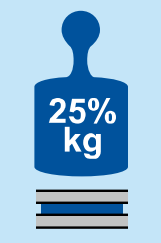To pick the correct slide for your application, it is important to know the load it will need to support.
Our slides are rated by load and we will always give the maximum load rating for our products. This is the maximum load that a pair of slides can carry, but only IF you mount them as instructed and don’t exceed their cycle rating. The stated load ratings are a gross load, so don’t forget to add the weight of the drawer construction materials to your calculations.

Other parameters to consider when considering your load:
- The orientation of the slide in its final application will have an effect on the load rating. Horizontally (flat) mounting slides reduces the load capacity to at least 25% of the vertical (side) mount capacity. Not all slide models can be used in flat mount applications. For more information read our blog about flat mounting.

This sign directly shows you the load rating of the slide when it is horizontally (flat) mounted compared to the load rating when vertical mounted.

- The speed and acceleration required can also affect what the slide can realistically support without sacrificing fast access where required. If the application requires movement over a long travel length, then the linear bearings must be parallel to each other to prevent racking and endure smooth travel. Short travel lengths present their own problems of potentially not providing enough space for recirculating ball bearings to be properly lubricated, which is why it is paramount to understand which type of linear guide is most suitable for your project.
Mounting the slides in different configurations will affect performance and load rating.
Please see individual product datasheets for more information on load ratings.
There are many other factors to consider when deciding the suitability of each slide for your project. Already have an idea of your requirements? If so, contact us.
